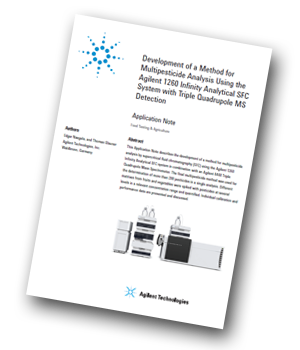Agilent has produced an application note describing the development of a method for multipesticide analysis by supercritical fluid chromatography (SFC) using the Agilent 1260 Infinity Analytical SFC system in combination with an Agilent 6460 Triple Quadrupole Mass Spectrometer. The final multipesticide method was used for the determination of more than 200 pesticides in a single analysis. Different matrixes from fruits and vegetables were spiked with pesticides at several levels in a relevant concentration range and quantified. Individual calibration and performance data are presented and discussed.
 Introduction
Introduction
Today, several hundreds of pesticide compounds are available on the market, and are in use on a worldwide basis for protection against various pests of plant food products such as vegetables, fruits, corn, and grain. Before plant-based food products enter the market, they have to be tested for possible pesticide residues, and they have to meet the legal limits.
This Application Note demonstrates the detection of more than 200 pesticide residues by SFC with triple quadrupole mass spectrometry in complex food matrixes after optimization of the SFC separation of a multiple-pesticide standard. The advantages of using an SFC as a front end for mass spectrometry for the analysis of pesticides in plant food samples are the separation speed, the orthogonal selectivity to LC, and the tolerance to injections with organic solvents as they are obtained from sample preparation. Data about the limits of detection (LODs), limits of quantitation (LOQs), linearity, retention time, and area RSDs of selected individual compounds are presented.
Results and Discussion
The Agilent LC/MS Pesticides Comprehensive Test Mix contains eight submixtures, each with approximately
33 compounds. These mixtures were used to develop and optimize the SFC separation method. The amino phase column was chosen due to experience based on an earlier method development work for a multipesticide sample. Ethanol was chosen as a modifier due to its lower elution strength compared to methanol, to enable a broader elution range.
Conclusion
This Application Note describes the development of a multipesticide method for SFC coupled to triple quadrupole MS for the determination of 223 pesticide compounds. In this method, the majority of 195 pesticide compounds eluted within 10 minutes using a gradient from 2 to 10 % organic modifier. By focusing on these pesticides, this could shorten the method dramatically compared to typical HPLC methods for the measurement of the same number of compounds.




